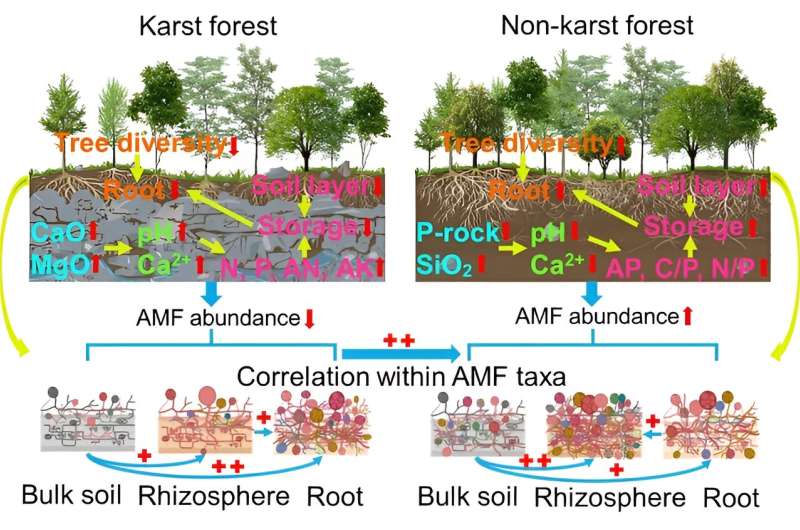This article has been reviewed according to Science X's editorial process and policies. Editors have highlighted the following attributes while ensuring the content's credibility:
fact-checked
trusted source
proofread
Lithology and niche habitat effectively control arbuscular mycorrhizal fungi

Karst landscapes are found worldwide, with the karst region in southwest China accounting for 5.8% of the national land area. The different chemical properties of the bedrock between karst carbonate rocks and non-karst clastic rocks are important factors influencing the arbuscular mycorrhizal fungi (AMF) community by altering soil properties and plant diversity.
Researchers led by Prof. Wang Kelin from the Institute of Subtropical Agriculture of the Chinese Academy of Sciences (CAS) have found that lithology and niche habitat have a significant effect on the abundance of arbuscular mycorrhizal fungi and their interspecific interactions.
In their study published in Science of The Total Environment on Feb. 9, the researchers conducted a detailed study to assess changes in the composition and diversity of AMF communities in bulk soil, rhizosphere soil, and roots in both karst and non-karst forests.
Karst carbonate rocks increased soil nitrogen (N) and phosphorus (P) levels compared to non-karst clastic rocks. This increase can be attributed to a high rate of bedrock weathering and increased soil Ca2+ and Mg2+ content, as well as pH, which is facilitated by the high CaO content and Ca/Mg ratio found in the bedrock of karst forests.
However, non-karst forests with thicker soil layers exhibited superior soil nutrient storage, leading to greater tree diversity. This diversity, coupled with abundant root biomass and root exudates, contributed to higher AMF abundance and stronger interactions among AMF taxa in both bulk and rhizosphere soils of non-karst clastic rocks, compared to karst carbonate rocks.
In addition, increased nutrient availability in the rhizosphere soil and roots leads to an increase in AMF abundance and diversity compared to bulk soil. In this situation, a more complex network within AMF taxa was observed in rhizosphere soil and roots compared to bulk soil due to the increase in AMF abundance and diversity in rhizosphere soil and roots.
The results highlight the ecological importance of lithology and niche habitats in determining the distribution of AMF communities, emphasizing their role in nutrient cycling and tree species coexistence. By recognizing the role of lithology and niche habitats in shaping AMF communities, we can better manage and conserve forest ecosystems to promote plant growth, vegetation recovery, and sustainable development.
More information: Dan Xiao et al, Lithology and niche habitat have significant effect on arbuscular mycorrhizal fungal abundance and their interspecific interactions, Science of The Total Environment (2024). DOI: 10.1016/j.scitotenv.2024.170774
Provided by Chinese Academy of Sciences




















